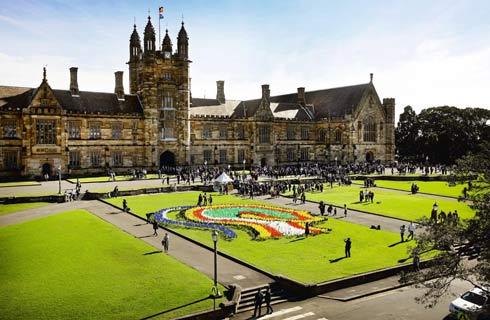Doctor of Philosophy in Atmospheric and Oceanic Sciences - Climate Dynamics

学历文凭
Ph.D.

专业院系
大气科学与气象

开学时间

课程时长

课程学费

国际学生入学条件
Hold a baccalaureate degree from a college or university of recognized standing, or have done work equivalent to that required for such a degree. Show promise of ability to pursue advanced study and research, as judged by the student's previous scholastic record and letters of reference. Have had adequate preparation to enter graduate study in the chosen field. Have at least a 3.00 (B) undergraduate grade point average. The University requires a minimum TOEFL score of 537 (paper based), 203 (computer based), and/or 75 (new internet based). The University requires a minimum IELTS score of 6.0.
IDP—雅思考试联合主办方

雅思考试总分
6.0
了解更多
- 雅思总分:6
- 托福网考总分:75
- 托福笔试总分:537
- 其他语言考试:NA
CRICOS代码:
申请截止日期:请 与IDP联系 以获取详细信息。
课程简介
Many of the most pressing problems in environmental science, such as El Nino, the ozone hole, and global warming intimately involve the motions of the atmosphere and the oceans. Students and faculty in ATOC approach the study of the dynamics of atmospheres and oceans from several perspectives. Field programs that employ fixed arrays of instruments, or highly instrumented platforms such as research ships, research aircraft, satellites, and remote pilotless drones, generate data sets that reveal new dynamic phenomena, or which may be used to test theoretical ideas or models. Computational simulations are used to explore the interactions between fluid motions and various physical/chemical processes that are now recognized as being closely coupled to dynamics. Models of global phenomena permit close-up study of the mechanisms that may govern the complicated behavior observed both in the models themselves and in nature. Research in the fundamental theory of waves, instabilities, and turbulence is carried out using idealized analytical study, and by the construction of mechanistic or process models that attempt to isolate key interactions for detailed interpretation. Laboratory experiments in fluid instability and turbulence are yet another point of view, yielding data from controlled systems run at parameter settings well beyond those accessible through direct numerical simulation. Finally, investigations of the circulations of other planetary atmospheres, as well as large-scale motions the solar atmosphere, provide an interesting test of theories and ideas about dynamical behavior at conditions far removed from those prevalent on Earth.
相关申请

预科

奖学金

实习机会

在校学习

跨境学习

校园授课-线上开始

在线/远程学习
学校排名
世界排名
124
数据源:泰晤士高等教育世界大学排名
关于科罗拉多大学博尔德分校

科罗拉多大学波德分校成立于1877年,是落基山地区优秀的综合性研究型大学,该校的自然科学、工程学、商务、法律、艺术、人文、教育、音乐等学科尤为突出。科罗拉多大学波德分校校园景色壮观美丽,吸引了一流的师资和来自世界各自的莘莘学子,共同构建了一个充满活力的校园环境。科罗拉多大学波德分校距离卡罗拉多州首府丹佛仅30英里(48公里)只需短程驾车便可达到美国发展最快的城市之一。由于临近丹佛,科罗拉多大学波德分校也接近许多主要的文化圣地、有许多实习和工作机会。学校附近的实习和工作单位:IBM、波音、谷歌。科罗拉多大学波德分校是久负盛名的“美国大学协会”的34 所公立大学之一,是一所具有卓越学术和尖端科研的美国顶级高校。该校强大的校友网、与龙头企业密切合作、高排名的学术成就、丰富的校园及社区活动为学生学业及未来职业发展提供了无限机遇。
本校相关课程
戏剧与表演研究哲学博士

学历文凭
Ph.D.
下一个开始日期
课程费用总额
戏剧和表演研究文学硕士

学历文凭
Masters Degree
下一个开始日期
课程费用总额
工商管理硕士/电信科学硕士

学历文凭
Double Major Degree
下一个开始日期
课程费用总额
技术,媒体与社会哲学博士

学历文凭
Ph.D.
下一个开始日期
课程费用总额
技术,媒体和社会科学硕士-创意技术和设计(CTD)

学历文凭
Masters Degree
下一个开始日期
课程费用总额
听力学博士学位

学历文凭
Ph.D.
下一个开始日期
课程费用总额
其他相关课程
化学理学士-大气与环境(荣誉学位)

麦吉尔大学继续教育学院
泰晤士高等教育世界大学排名:

学历文凭
Bachelor Degree with Honours
下一个开始日期
课程费用总额
化学理学学士-大气与环境

麦吉尔大学继续教育学院
泰晤士高等教育世界大学排名:

学历文凭
Bachelor Degree
下一个开始日期
课程费用总额
大气科学(荣誉)理学学士

麦吉尔大学继续教育学院
泰晤士高等教育世界大学排名:

学历文凭
Bachelor Degree with Honours
下一个开始日期
课程费用总额
大气科学理学学士

麦吉尔大学继续教育学院
泰晤士高等教育世界大学排名:

学历文凭
Bachelor Degree
下一个开始日期
课程费用总额
环境科学学士-大气环境与空气质量

麦吉尔大学继续教育学院
泰晤士高等教育世界大学排名:

学历文凭
Bachelor Degree
下一个开始日期
课程费用总额
地球与大气科学理学学士

约克大学
泰晤士高等教育世界大学排名:

学历文凭
Bachelor Degree
下一个开始日期
课程费用总额




